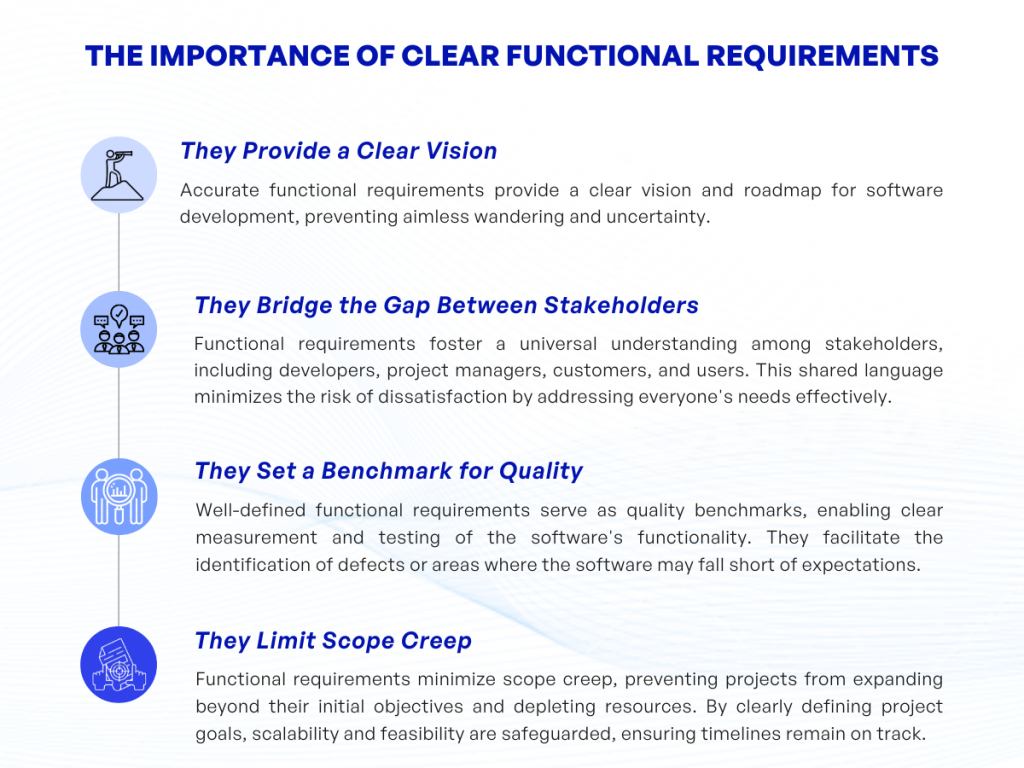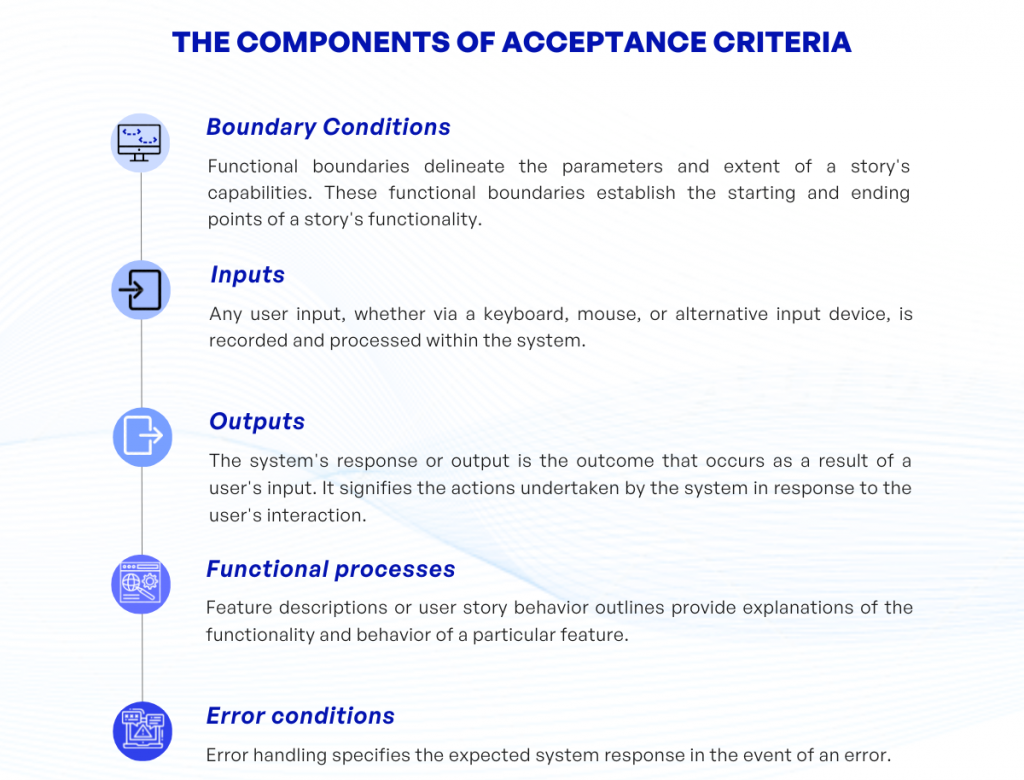
Did you know that 71% of software projects fail because of poor requirement analysis? Yes, that’s correct. Poorly defined or misunderstood functional requirements in software development can lead to project failure. Here, we’ll dive into the nuts and bolts of functional requirements, explaining what they are, why they are crucial, and how clearly defining them can significantly increase the success rate of your software project.
Defining requirements clearly is of paramount importance in achieving project success, especially in software development projects.
1. Understanding Functional Requirements
Ever wondered what makes an application do what it does? How does it know exactly what the user wants? Ah, the secret lies within functional requirements. Now, you might ask yourself, “What exactly are functional requirements in software development?”
Functional requirements are essentially the specifications that describe the system’s behavior under specific conditions. They outline all the functionalities that need to be implemented in the software system so it can perform its intended function.
Take an email application, for example. When you hit the ‘send’ button, you expect the email to be delivered to the recipient, right? That’s the application fulfilling a functional requirement. Also, you’d expect an alert if you try to send an email without a recipient listed – another functional requirement. Essentially, they dictate the operations and activities a software system should be capable of performing.
Oh, and it’s not just about what the system should do. Functional requirements also include data manipulation, calculations, business processes, user interaction, and even specifics regarding system performance and error handling.
But why is it important to understand functional requirements? Well, stick around. We’ll dive into that next.
2. The Importance of Clear Functional Requirements
Ever find yourself wondering why exactly are these functional requirements so essential to the software development process? Let’s dive right into this query. Having clear and concise functional requirements can literally be the make or break point for your software project. So, what exactly makes them so crucial?

2.1. They Provide a Clear Vision
Your functional requirements, when defined accurately, give you and your software development team a clear vision of what needs to be achieved. Think of them as a roadmap, guiding your software development process. Without them, you might end up wandering aimlessly, unsure of your ultimate destination.
2.2. They Bridge the Gap Between Stakeholders
Functional requirements provide a common language between various stakeholders, including developers, project managers, customers, and users. This universal understanding helps ensure everyone’s needs are adequately addressed, reducing the risk of later dissatisfaction.
2.3. They Set a Benchmark for Quality
Well-defined functional requirements act as quality benchmarks, providing a clear measurement against which the software’s functionality can be tested. They make it easier to identify defects or areas where the software may fall short of expectations.
2.4. They Limit Scope Creep
Finally, functional requirements can greatly reduce scope creep, which refers to a project expanding beyond its initial objectives. We all know how quickly that can deplete resources and derail timelines. By clearly defining what must be accomplished, scope creep can be kept at bay, safeguarding your project’s scalability and feasibility.
Understanding the importance of clear functional requirements highlights the significance of investing in this stage of the project. Do you see now why they are such crucial parts of the software development process?
3. User Stories: Functional Requirements in Agile Development
So, what does a functional requirement look like in the agile software development world? This is where the concept of a ‘user story’ comes into play.
You see, Agile development focuses mainly on user-centricity. In this context, functional requirements are often crystalized into concise, actionable narratives known as ‘user stories’. This approach simplifies the process of defining what the system should do from an end-user’s perspective.
A typical user story takes the form: As a (type of user), I want (some goal) so that (some reason). This brief but holistic structure ensures that all necessary aspects are catered for: the user type, their goal, and the purpose backing that goal.
For instance, a user story in a banking application might read: As an Account Holder, I want to transfer funds to other banks, so that I can pay bills in a timely manner.
The beauty of user stories lies in their simplicity and clarity. They are free of technical jargon, facilitating crystal clear communication of what users need from the system. As a result, not only technical team members but non-technical stakeholders, such as business managers or clients, can also participate actively in shaping the product.
These stories also aid in creating documentation and help define the criteria for user acceptance testing. They ensure that everyone is on the same page, about what is to be built and why.
By adopting this simple, yet effective method, Agile development directly ties functional requirements to user value, making it a winning approach for crafting software that meets users’ needs and delivers a superior end-user experience.
4. Acceptance Criteria for User Stories
Have you ever wondered what acceptance criteria are and why it’s crucial in user stories? Well, acceptance criteria are essentially the conditions that a software product must meet to be accepted by a user, customer, or in the case of system-level functionality, the consuming system.
Now, you might ask, why is that important? To begin with, these criteria provide developers with a clear and detailed specification of what the end product should do, and how it should function from the user’s perspective. This includes specifics for different features, their defined scope, and the expected behavior of the software.
Acceptance Criteria serve as the guidepost of what the team must achieve to deliver value to the customer.
5. The Components of Acceptance Criteria

So, what exactly makes up the acceptance criteria? Here’s a simple breakdown:
- Boundary Conditions: These are the edges or limits of a story’s functionality. They define where the function starts and ends.
- Inputs: Anything entered in the system by the user, whether it’s through a keyboard, mouse, or a different input device.
- Outputs: The result or the reaction of the system to an input. It describes what the system does in response to the user’s action.
- Functional processes: Descriptions of what the feature does or how a user story behaves.
- Error conditions: How the system should respond if an error occurs.
These components help in enhancing the visibility of user stories, which in turn leads to better product development. See how crucial acceptance criteria are?
6. Example of Acceptance Criteria
Now, let’s consider an example to familiarize ourselves better with the concept. Suppose we have the user story: “As a user, I want to be able to reset my password so that I can regain access when I forget it.”
The acceptance criteria for this story might include:
1. When a user inputs an incorrect password, they should be prompted with the ‘forgot password’ option.
2. When the ‘forgot password’ option is chosen, the user should be asked to enter their email.
3. The system should send a password reset link to the entered email.
4. The user should be able to establish a new password using the link.
5. After resetting the password, the user should be able to log in with the new password.
Through this descriptive criterion, the entire team knows what needs to be implemented to meet the user’s needs perfectly.
7. Conclusion
In conclusion, by enacting clear, precise, and well-constructed functional requirements, you maximize the chances of your project’s success. They provide a clear vision, bridge the gaps between stakeholders, set quality benchmarks, and restrict scope creep. In the agile sphere, user stories and acceptance criteria take center stage, providing a layer of granularity and specificity.
In essence, functional requirements are not just about describing what the software should do, but also how it should do it. They are fundamentally important in shaping the direction and end result of a project. Remember, the devil is in the detail. So, is your project adequately defining its functional requirements?
With the right approach, functional requirements can steer your project towards a successful path. Don’t underestimate their importance. Instead, let them guide you to deliver an end product that meets users’ needs and surpasses their expectations.
If you have any questions regarding functional requirements, feel free to contact KVY TECH.


